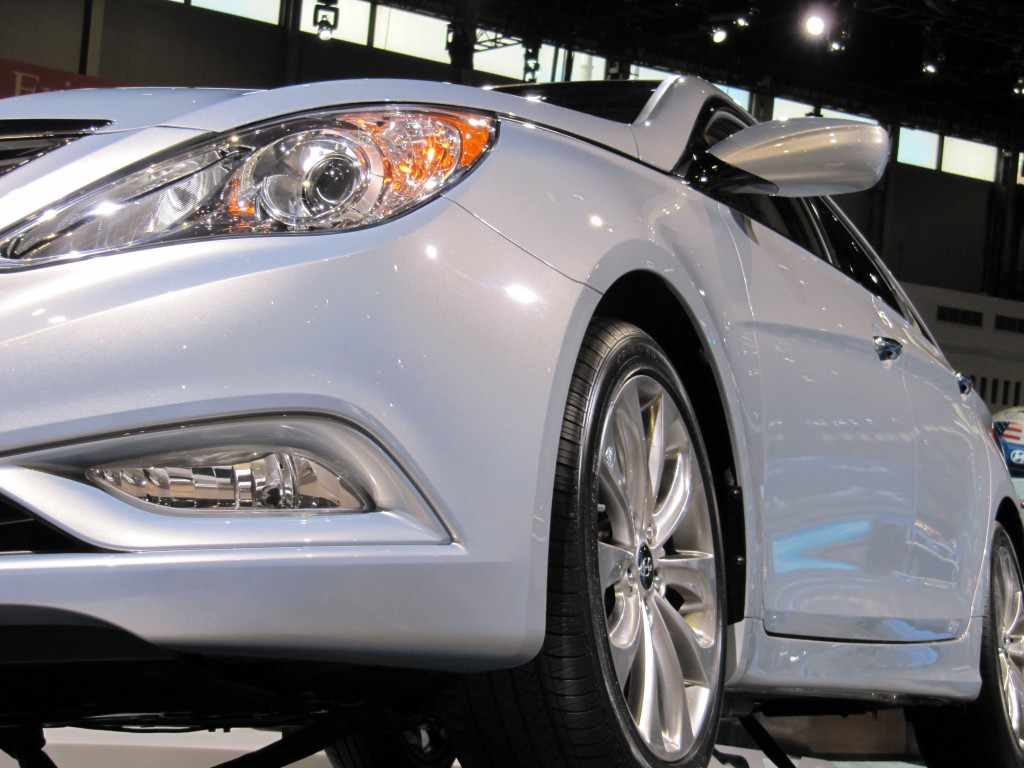Based on what you see above, you’ll agree that this new 2011 Hyundai Sonata (no, that isn’t the Passat CC) has more inspired and engaging styling than the benchmark Toyota Camry. But what you can’t tell from the pictures is how the car feels. So let me tell you that it feels solid and well screwed together. Like, no joke. In fact, I’ll go as far to say that the new Sonata is better than the Camry, and for that matter all the other midsize sedans. I had an inkling that this statement might be true, but the Korean company’s presence at the 2010 Chicago Auto Show cemented it for me.
It was there that I saw the 2011 Sonata in the metal and had the opportunity to explore the car a bit. This car was so surprisingly adequate that I needed to compare it to Toyota, the reigning champion of North American sales. And adequacy. But I’ll get to that in a second because there were also the 2010 Tuscon, the Genesis brothers, and the Genesis Coupe drift car that some dude named Rhys Millen uses to extract smoke out of rubber. And all of these cars had a big impact on me. I know it has been said before that Toyota’s quality is slipping, but it wasn’t clear to me how badly the Koreans are now beating the Japanese titan, and therefore everyone else. But it isn’t just Hyundai that is sneaking up on the Big Two of GM and Toyota, it’s Volkswagen too. It has been well-publisized that Volkswagen plans to be the world’s largest automaker by 2018, but based on what I saw at the CAS, I wouldn’t be surprised if it were the Koreans first. Either way, both brands are on the rise.
More proof and less rhetoric are below.
One big difference between Hyundai/Volkswagen and Toyota is the perception of interior quality. This basically comes down to using plastics that feel agreeable to touch and buttons/knobs that don’t feel like they were made by the Playskool children’s brand, if that doesn’t sound too cliché. Softer materials that don’t echo when used are usually best. Hyundai has figured this out. Toyota has forgotten it.
Now, this is hardly comparing apples to apples, or even apples to oranges, in fact this should be like comparing a Bentley to a 3-series, but I’ll let you be the judge.
That interior wouldn’t win anyone over if it were found in a Yaris, but it was found in a USD$60,000 Toyota Sequoia, and it pales in comparison to the new Volkswagens and Hyundais costing a third as much.
See what I mean? This is a $20,000 Volkswagen and it’s awesome.
And now a $20,000 Hyundai.
Value is all about perception, and when quality can be had at lower prices, that’s doubly attractive. Ah, yes. Quality – that ever-important sensory subjective. It isn’t just looks that give quality, these new cars are remarkably well put-together, with doors that don’t sound nearly as tinny as the new Prius. The new Hyundais have quality in spades and the Volkswagens never really lost it.
The styling is another area of drastic improvement. The Hyundais now look Germanically-styled, partly because they are, and the Volkswagen MkVI Golf and Passat CC are leading a more exciting design direction than what we saw in the early part of the decade. The difference is that the Sonata has pulled off the trick of using sleek curves that don’t limit interior space, something the Passat CC can’t muster. Well played, Hyundai. I may be going out on a limb here, but we may look back on the 2011 Hyundai Sonata and the Volkswagen Golf MkVI the same was we do the third-generation Toyota Camry and the W124 Mercedes E-Class. Just maybe.
Amazingly
For more videos, you can check out our YouTube page at https://www.youtube.com/user/CarEnvy.
[Source credits: author (1, gallery), YouTube, scottx/Flikr (2), World Hyundai/Flikr (3)]






















